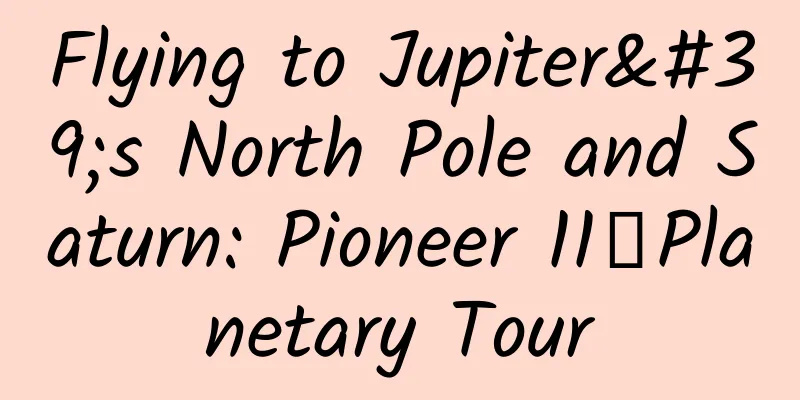Flying to Jupiter's North Pole and Saturn: Pioneer 11丨Planetary Tour

|
Pioneer 11 was the first probe to explore Saturn at close range, and the first probe to successfully observe the north and south poles of Jupiter. It was the successor to Pioneer 10 and the predecessor to Voyager 2. Its success has greatly advanced the pace of human exploration of the "outer planets" (Jupiter, Saturn, Uranus and Neptune), and has accumulated valuable experience for some of the outer planet probes that have carried out missions since then. In particular, it checked the safety of the planned route for Voyager 2, paved the way for the latter to successfully explore Uranus and Neptune, and played an irreplaceable and important role in helping humans achieve the feat of "planetary grand tour". Written by | Wang Shanqin The success of Pioneer 10 not only realized the human dream of exploring Jupiter at close range, greatly enhancing human confidence in exploring outer planets, but also enabled its sister probe, Pioneer 11, to switch from spare mode to independent probe mode. The Pioneer team of NASA's Ames Research Center (ARC) officially launched the plan to explore Saturn with Pioneer 11. The specific steps of this plan are: Pioneer 11 will first visit Jupiter, then use Jupiter's gravitational slingshot effect to accelerate and change orbit, and then head straight to Saturn to achieve an ice-breaking journey for Saturn exploration. More or less the same: Pioneer 11's structure The structure of Pioneer 11 is exactly the same as that of Pioneer 10, both of which have nuclear batteries to provide electricity, antenna systems to maintain communications and transmit data, important instruments for detection, and systems for positioning and navigation. The instruments carried by Pioneer 11 are basically the same as those carried by Pioneer 10 (see the figure below) [1] However, Pioneer 11 has one more instrument than Pioneer 10 : the fluxgate magnetometer. This additional instrument makes it 0.5 kg heavier than Pioneer 10, so its total mass is 258.5 kg. A diagram of the structure of Pioneer 11 (also Pioneer 10). The medium-gain antenna is not labeled in the middle of the main antenna (high-gain antenna). Image source: NASA, Vectors by Mysid; Image text translation: Wang Shanqin In addition, due to the launch time of more than a year later, the instruments on Pioneer 11, especially those related to detecting magnetic fields and radiation, have been improved to a certain extent. The propulsion system, communication system, and nuclear battery system of Pioneer 11 are also exactly the same as those of Pioneer 10. At 02:11:00 on April 6, 1973 (UTC), Pioneer 11 was launched on an Atlas-Centaur rocket. The rocket that sent it into space was equipped with a solid engine to allow the probe to achieve a higher speed. At this time, Pioneer 10, which had been launched about 13 months ago, had left the asteroid belt and was on its way to Jupiter, but had not yet begun to explore Jupiter. Pioneer 11 rocket lifts off. Image credit: NASA Marshall Space Flight Center (NASA-MSFC) Pioneer 11 safely passed through the asteroid belt in mid-March 1974. On April 11, 1973, Pioneer 11 made an orbit correction. A critical change of track On January 1, 1974, Pioneer 10 successfully completed its Jupiter exploration mission. Pioneer 11 was no longer used as a spare for Pioneer 10, but was instead assigned to explore Saturn. However, it still had to fly past Jupiter first, thereby changing its trajectory and accelerating with the help of Jupiter's gravitational slingshot effect. After confirming the great success of Pioneer 10, the Voyager team hoped that Pioneer 11 could approach Jupiter at a closer distance to pave the way for future Voyager flybys of Jupiter. A closer route means greater risk, so some members of the Pioneer team opposed this suggestion. But after weighing the pros and cons, the Pioneer team finally agreed to this suggestion. After all, a closer distance not only means risks, but also means huge benefits: high-definition images of Jupiter can be obtained . On April 26, 1974, the Pioneer team issued a command to correct Pioneer 11's trajectory to achieve three goals. First, Pioneer 11 will be closer to Jupiter than Pioneer 10, allowing for higher-resolution observations. Secondly, the orbital plane of Pioneer 11 will be at an angle of 52 degrees to the equatorial plane of Jupiter. This brings two advantages: (1) It can observe the north and south poles of Jupiter when entering the Jupiter system. (2) It can minimize the radiation dose of Jupiter received by Pioneer 11 - the previous detection of Pioneer 10 showed that Jupiter's magnetic field is a toroidal magnetic field around Jupiter's equatorial plane. Flying along such an orbit can minimize the duration of Jupiter's magnetic field and radiation affecting the instrument. Third, the revised orbit will fly past Jupiter in a retrograde manner, meaning it will be moving in the opposite direction of Jupiter's rotation. This will allow it to see more of Jupiter in a shorter period of time and better measure Jupiter's magnetic field. Exploring the Jovian system On November 7, 1974, Pioneer 11 made a trajectory change and began to enter the Jupiter system. At 03:39 on November 25, Pioneer 11 passed through Jupiter's bow shock. Next, Pioneer 11 began to fly by Jupiter and its satellites. Pioneer 11 and Pioneer 10 flyby routes of the Jupiter system (Jupiter and its satellites) (a bird's-eye view of the Jupiter system's orbital plane). It can be seen that the directions of Pioneer 11 and Pioneer 10's routes around Jupiter are opposite. Image source: On December 2, 1974, Pioneer 11 flew past Callisto (786,500 km away) and Ganymede (692,300 km away); on December 3, Pioneer 11 flew past Io (314,000 km away) and Europa (586,700 km away). [2] Compared to Pioneer 10, Pioneer 11 flew past Jupiter's four satellites at different distances. On December 2, 1974, Pioneer 11 photographed the crescent-shaped Io from a distance of 756,000 kilometers. Image credit: NASA/Ames Images of Jupiter's four "Galilean satellites" taken by Pioneer 10 and Pioneer 11 in 1973 and 1974, from left to right: Io, Europa, Ganymede, and Callisto. The image of Io was obtained by Pioneer 11. Image source: https://history.nasa.gov/SP-349/p180.htm At 5:02 on December 3, 1974, Pioneer 11 passed behind Jupiter (relative to the Earth's line of sight), and 19 minutes later, Pioneer 11 reached Jupiter's perigee, at which time it was 42,828 kilometers away from Jupiter's cloud tops. In comparison, the distance between Pioneer 10's perigee and Jupiter's cloud tops was 132,000 kilometers. Therefore, Pioneer 11 was much closer to Jupiter than Pioneer 10, only 1/3 of the latter's distance, which enabled it to obtain much clearer images of Jupiter than the latter. Pioneer 11 captured a clear image of Jupiter's Great Red Spot when it was 31 degrees south latitude and 545,000 kilometers from Jupiter. Image source: NASA Before reaching Jupiter's perihelion, Pioneer 11 reached a speed of 47.5 kilometers per second, becoming the fastest man-made object up to that time. Like Pioneer 10, Pioneer 11 had no data storage equipment on board and could only send data immediately as it was acquired, so any data it captured could not be transmitted to Earth when it passed behind Jupiter. At 5:44 on December 3, 1974, Pioneer 11 came out from behind Jupiter and began to resend the acquired data. Then, it flew at high speed to the north pole of Jupiter. At 09:27 on December 3, Pioneer 11 photographed Jupiter's north pole, when it was 435,000 kilometers away from Jupiter. This was the first time humans saw Jupiter's polar region. In the image of Jupiter's north pole taken by Pioneer 11, the resolution reached 152 kilometers per pixel. [3] Previously, astronomers speculated that the atmosphere in Jupiter's polar regions was more transparent than that in its equatorial regions, and that observing its north and south poles would allow for a deeper look into the atmosphere. An image of Jupiter's north pole taken by Pioneer 11. Image credit: NASA Because its speed is higher than that of Pioneer 10 and its orbital plane is at a larger angle to Jupiter's equatorial plane, it suffered less damage from Jupiter's annular radiation belt than Pioneer 10 during its flyby of Jupiter. On December 3, 1974, Pioneer 11 flew past Europa (at a distance of 127,500 km) and determined its mass. Pioneer 10 had not previously flown past it. Pioneer 11 stopped its exploration of Jupiter on January 1, 1975. During its exploration of the Jupiter system, Pioneer 11 sent back hundreds of photos of Jupiter and its satellites, made infrared measurements of Jupiter, and obtained data on magnetic fields and charged particles. Flying to Saturn: Debate, Compromise, and Sacrifice Due to the huge gravitational pull of Jupiter, the orbit of Pioneer 11 was deflected at a large angle. After that, the Pioneer team issued instructions to make two orbit changes on May 26, 1976 and July 13, 1978, further correcting its orbit and making it fly to Saturn on the other side of the orbit. The orbit of Pioneer 11. It was launched from Earth in April 1973 and flew past the Jupiter system in December 1974. Under the influence of Jupiter's gravity, its orbit changed significantly. After that, the probe ejected its own propellant to change its orbit and fly to Saturn. It flew past the Saturn system in September 1979 and then left the solar system. Image source: NASA; Image text translation: Wang Shanqin At that time, the Voyager project had been approved, and the relevant team had been established and determined the subsequent plans: Voyager 1 would continue to explore the Jupiter system and the Saturn system to obtain clearer images; Voyager 2 would carry out the mission of Voyager 1 (if Voyager 1 failed), or explore Jupiter, Saturn, Uranus and Neptune (if Voyager 1 succeeded). A key step for Voyager 2 to fly to Uranus is to pass through Saturn's A ring and use Saturn's gravitational slingshot effect to complete the orbit change and acceleration. To ensure safety, the Voyager team suggested that Pioneer 11 pass through Saturn's A ring first to determine whether the particles in the A ring would damage the probe. After discussion, the Pioneer team agreed to this plan. However, the two teams disagreed on the route the probe should take after passing through Saturn's A ring: the Pioneer team wanted Pioneer 11 to head toward Saturn's inner rings, directly explore Saturn's inner rings, and determine whether the previously controversial D ring exists. The Voyager team asked Pioneer 11 to head toward Saturn's outer rings, pass through Saturn's E ring, and then leave the Saturn system to determine whether the Voyager 2 probe would be harmed by particles from Saturn's outer rings when passing through this route in the future. The Pioneer team believed that if Pioneer 11 took the route given by the Voyager team, it would get farther and farther away from Saturn, and would not be able to obtain the higher-resolution observations that astronomers are interested in, let alone directly detect Saturn's inner rings. The Voyager team also insisted on its own suggestion: if Pioneer 11 did not take this route, and Voyager 2 did not take the risk of taking this route, there would be no way to observe Uranus and Neptune. The two sides argued repeatedly, but neither could convince the other. The matter was brought to the attention of the two teams' common superior department, NASA headquarters. NASA headquarters agreed with the Voyager team's suggestion because although this route sacrificed observations of Saturn's inner rings and closer observations of Saturn itself, it was worth the sacrifice in order to allow Voyager 2 to explore Uranus and Neptune. When the head of NASA's planetary science department announced the decision, members of the Pioneer team at the scene booed in protest. Nevertheless, the Pioneer team must implement the decision of NASA headquarters. Flyby of the Saturn system Pioneer 11 began observing Saturn on July 31, 1979. At this time, Voyager 1 and Voyager 2 had also completed their exploration of Jupiter and were flying towards Saturn. Saturn, its rings and Rhea (the white dot to the lower right of Saturn) as captured by Pioneer 11 on August 26, 1979. Image credit: NASA On August 29, 1979, Pioneer 11 entered the Saturn system and flew past Iapetus (1,032,535 km away) and then Phoebe (13,713,574 km away). [2] On August 31, 1979, Pioneer 11 flew past Titan (666,153 km away). [2] On the same day, it detected Saturn's bow shock at a distance of 1.5 million km, providing the first observational evidence of Saturn's magnetic field. [1] On September 1, 1979, Pioneer 11 flew past Titan (6,676 km away), Titan (45,960 km away), Dione (291,556 km away), and Mimas (104,263 km away),[2] and passed through the plane outside Saturn's outer rings, approaching the A ring. At 16:29:34 on the same day, Pioneer 11 reached Saturn's perigee, at which point it was 20,591 km from Saturn's cloud tops and had a speed of 31.7 km/s. During its approach to and departure from Saturn, Pioneer 11 took 440 images of the Saturn system, about 20 of which were at a resolution of 90 km per pixel. [1] During this time, it also discovered Saturn's F ring and two new moons. After the flyby of Saturn, Pioneer 11 also flew past Titan's X-ray diffraction system (228,988 km away), Tethys (329,197 km away), Enceladus (222,027 km away), Rhea (109,916 km away), and Rhea (345,303 km away) on the same day. [2] Saturn and part of its rings as captured by Pioneer 11 on September 1, 1979. Image credit: NASA On September 2, 1979, Pioneer 11 flew past Titan (362,962 km away). The resolution of the photos it took of Titan reached up to 179 km per pixel. These images show that Titan is an orange-yellow satellite with no surface atmospheric features. Based on images in different bands, astronomers measured the diameter of Titan to be 5,690 or 5,760 km. The data also showed that the temperature at the top of Titan's cloud layer is about 75K (minus 198 degrees Celsius). [4] Titan, photographed by Pioneer 11 at a distance of 360,000 kilometers on September 2, 1979. Image source: NASA During the flyby of Saturn, Pioneer 11's infrared radiometer measured the infrared radiation of Saturn's upper atmosphere and, combined with radio occultation, determined the temperature, structure and other properties of Saturn's upper atmosphere. Its data showed that Saturn's average temperature was about -180 degrees Celsius and that its main component was liquid hydrogen, making it unsuitable for life. [1] Pioneer 11 then sped away from Saturn, toward its E ring. On October 5, 1979, Pioneer 11 completed its observations of the Saturn system. Flying away from the sun Under the influence of Saturn's gravity, Pioneer 11's orbit was deflected. It then flew away from the solar system towards the center of the Milky Way and began its interstellar mission. It should be noted that the direction it flew away from the sun was almost opposite to the direction of Pioneer 10. In 1995, Pioneer 11 could no longer power its instruments, and NASA decided to shut it down. On November 24, 1995, humans completely lost contact with Pioneer 11. Pioneer 11 is currently about 111 AU (about 16.6 billion km) from the Sun. Its current speed relative to the Sun is 11.182 km/s, and it is moving in the direction of the current Scutum at a speed of 2.36 AU per year. [2] Its speed has also exceeded the third cosmic velocity, so it can leave the solar system in the future. Pioneer 11 also carried a metal plate with the same symbols and patterns as those on Pioneer 10. (For details, see "Pioneer 10: Planetary Tour", a Pioneer in Exploring the Frontiers of the Solar System) Since Pioneer 10 only flew past Jupiter, while Pioneer 11 also flew past Saturn, the two orbits are different. Therefore, the route map on the Pioneer 11 plate is inaccurate. But this is a small problem. In 2019, someone[5] used the data on the position, speed and direction of stars obtained by the Gaia satellite to infer that in about 928,300 years, Pioneer 11 will fly past the dwarf star TYC 992-192-1, with a minimum distance of 0.8 light-years. This is the closest star it will encounter in the next 2.57 million years. Interlude: From spare parts to replicas, the pioneer H In 1971, Pioneer 10 and 11 had not yet been launched, and their numbers were still Pioneer F and Pioneer G. This year, the Pioneer team planned to launch Pioneer H in the future as a spare part for Pioneer G (Pioneer 11). According to the plan, Pioneer H will be launched in 1974 and fly past Jupiter in July 1975. Its orbital plane is perpendicular to Jupiter's equatorial plane, so it can fully observe Jupiter's north and south poles. If it is successfully launched, it will be renamed Pioneer 12. Unfortunately, NASA headquarters rejected this plan before Pioneer H was launched. Later, Pioneer H, with its nuclear battery removed, was placed in a museum as a replica of Pioneer 10 and 11. Pioneer H hangs in the museum, it is a replica of Pioneer 10 and Pioneer 11. Image credit: CamWow The name "Pioneer 12" was used by the Pioneer Venus Orbiter, which was launched on May 20, 1978, and was also known as Pioneer Venus 1. When Pioneer 11 flew past Jupiter, the angle between it and Jupiter's equatorial plane was 52 degrees, and it observed parts of Jupiter's north and south poles, thus partially achieving the goal of Pioneer H. The solar probe Ulysses and the Jupiter probe Juno, which were later launched, truly achieved the orbital mode of Pioneer H. Ulysses' angle with the solar equatorial plane reached 80.2 degrees, almost vertical. Juno was completely vertical to Jupiter's equatorial plane (the angle was 90 degrees), which is a typical polar orbit probe. Pioneer 11's historical contribution Pioneer 11 is the first probe to explore the Saturn system at close range, and it has realized the human dream of exploring the Saturn system at close range. After entering the Saturn system, various instruments on Pioneer 11 obtained data on Saturn, Saturn's rings and Saturn's satellites. The near-infrared data it obtained allowed astronomers to determine the temperature and structure of Saturn's upper atmosphere and the temperature of Titan; the quality of the images it obtained in the visible light band exceeded that of all telescopes on Earth at the time, becoming the first batch of precious images for astronomers to study the details of the Saturn system; the data on Saturn's magnetic field it obtained enabled astronomers to map the distribution, strength, direction and structure of Saturn's magnetosphere and magnetic field, and to determine the details of the interaction between solar wind particles and the Saturn system's magnetic field; its close-range observations provided a lot of details of Saturn's rings and helped astronomers discover Saturn's F ring; through flybys, it accurately determined the masses of Saturn and some of Saturn's satellites. In addition, although Pioneer 11 was not the first probe to explore the Jupiter system at close range, it obtained clearer images of Jupiter at a closer distance and obtained images of Jupiter's poles for the first time. Its exploration of Jupiter further deepened mankind's understanding of Jupiter's nature. To commemorate the significant contribution of unmanned spacecraft in exploring the planets and moon in the solar system, the U.S. Postal Service issued a set of 10 stamps on October 1, 1991, depicting the exploration of the "nine planets" and the moon in the solar system at that time (Pluto was still considered a planet at that time). In this set of stamps, the one for Jupiter is paired with Pioneer 11, not Pioneer 10, which was the first to explore Jupiter, while Saturn, Uranus and Neptune are all paired with Voyager 2. My personal opinion is that although Pioneer 11 and Voyager 2 made clearer observations of Jupiter and Saturn respectively, the first successful approaches and data transmissions were made by Pioneer 10 and 11. Therefore, a more reasonable combination might be: Jupiter - Pioneer 10, Saturn - Pioneer 11, Uranus and Neptune - Voyager 2. Jupiter and Pioneer 11 stamp issued on October 1, 1991. Image credit: United States Postal Service The success of Pioneer 11 also accumulated the first valuable experience for the subsequent Voyager 1, Voyager 2 and Cassini-Huygens probes to explore Saturn, and paved the way for Voyager 2 to explore Uranus and Neptune. In particular, it verified the particle environment inside Saturn's rings, ensuring that Voyager 2 could safely pass through the planned route in the future. The members of the Pioneer team were angry that Pioneer 11 sacrificed its final exploration target for Voyager 2, but they were relieved when Voyager 2 successfully explored Uranus and Neptune. They knew that Pioneer 11 had paved the way for Voyager 2 and made its own important contribution to human exploration of these two ice giant planets. References [1] In Depth: Pioneer 11, https://solarsystem.nasa.gov/missions/pioneer-11/in-depth/ [2] Wikipedia: Pioneer 11, https://en.wikipedia.org/wiki/Pioneer_11#cite_note-Pioneer_11-1 [3]Andrew LePage, Our First Good Look at Jupiter's North Pole – 1974, https://www.drewexmachina.com/2016/06/28/our-first-good-look-at-jupiters-north-pole-1974/ [4]Andrew LePage, Voyager 1: The First Close Encounter with Titan, https://www.drewexmachina.com/2015/11/12/voyager-1-the-first-close-encounter-with-titan/ [5]Bailer-Jones, Coryn AL & Farnocchia, Davide, Future Stellar Flybys of the Voyager and Pioneer Spacecraft, Research Notes of the American Astronomical Society, 2019, 3, 59. An extended version of this paper is available at: arXiv:1912.03503 ( This article is supported by the Science Popularization China Starry Sky Project Produced by: China Association for Science and Technology Department of Science Popularization Producer: China Science and Technology Press Co., Ltd., Beijing Zhongke Xinghe Culture Media Co., Ltd. Special Tips 1. Go to the "Featured Column" at the bottom of the menu of the "Fanpu" WeChat public account to read a series of popular science articles on different topics. 2. Fanpu provides a function to search articles by month. Follow the official account and reply with the four-digit year + month, such as "1903", to get the article index for March 2019, and so on. Copyright statement: Personal forwarding is welcome. Any form of media or organization is not allowed to reprint or excerpt without authorization. For reprint authorization, please contact the backstage of the "Fanpu" WeChat public account. |
<<: Who opened the first page of the book of the Qinghai-Tibet Plateau’s stratigraphic structure?
>>: There are too many leftovers during the Spring Festival! How to deal with them safely?
Recommend
Case Analysis: How to use the AARRR model to increase user growth?
This article takes Luckin Coffee as an example. I...
Dongfeng is not in debt. Has the window of opportunity for OLED TV explosion arrived?
It is said in "The Art of War" that &qu...
Why are there debris after a rocket is launched? How serious are the consequences if it falls to the ground?
In recent times, some foreign media have been con...
From Tencent Zhihui to social advertising, how native advertising can help precision marketing
Tencent products, a high-quality performance mark...
15 thoughts on copywriting, marketing, and life!
1. There is a marketing operation trick called pi...
Cancer incidence maps for each province released! Check out which cancer you need to be most careful about!
Nasopharyngeal cancer is more common in Guangdong...
Collection | 12 major overseas app promotion methods
This year is still a hot year for going overseas....
What are the benefits of Douyin Blue V enterprise certification? How to apply for Douyin Blue V certification?
When most people operate a Douyin account, they c...
Deconstructing community growth: sending red envelopes, group points, and super users!
I have been engaged in community marketing for th...
WeChat Mini Programs are popular. I have summarized the 4 best ways to learn mini programs by yourself in terms of product and operation.
With the public beta release of WeChat Mini Progr...
#千万IP创科学热门#丨Minnan flower bricks, can cement also bloom?
Minnan tiles are traditional architectural decora...
New research: Tiny electric sparks from waves hitting the shore may be the spark of the origin of life on Earth
In science fiction, the birth of life is sometime...
The first choice of 6-seater pure electric SUV, WM EX6 Plus 6-seater will be available for pre-sale soon
What is a 6-seater pure electric SUV? A tough guy...
Live broadcast process planning and promotion methods!
Live streaming e-commerce is like a super “human ...
Is the Coocaa art TV that sells for 8,000 yuan really just a passing fad?
Art is a general term for talent and technology, ...









